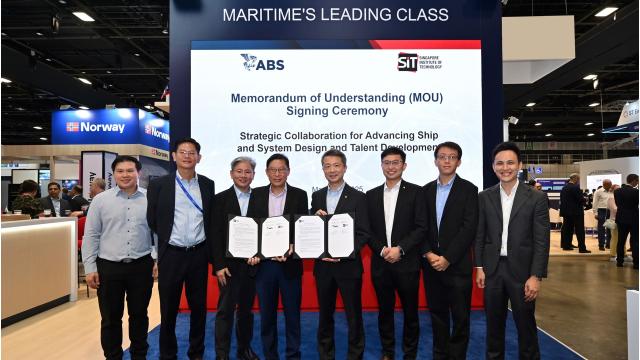A new welding protocol formulated by two SIT professors has unlocked stronger, yet lighter steel for construction use and clinched the Applied Research Excellence Award at the SIT University Awards 2024.
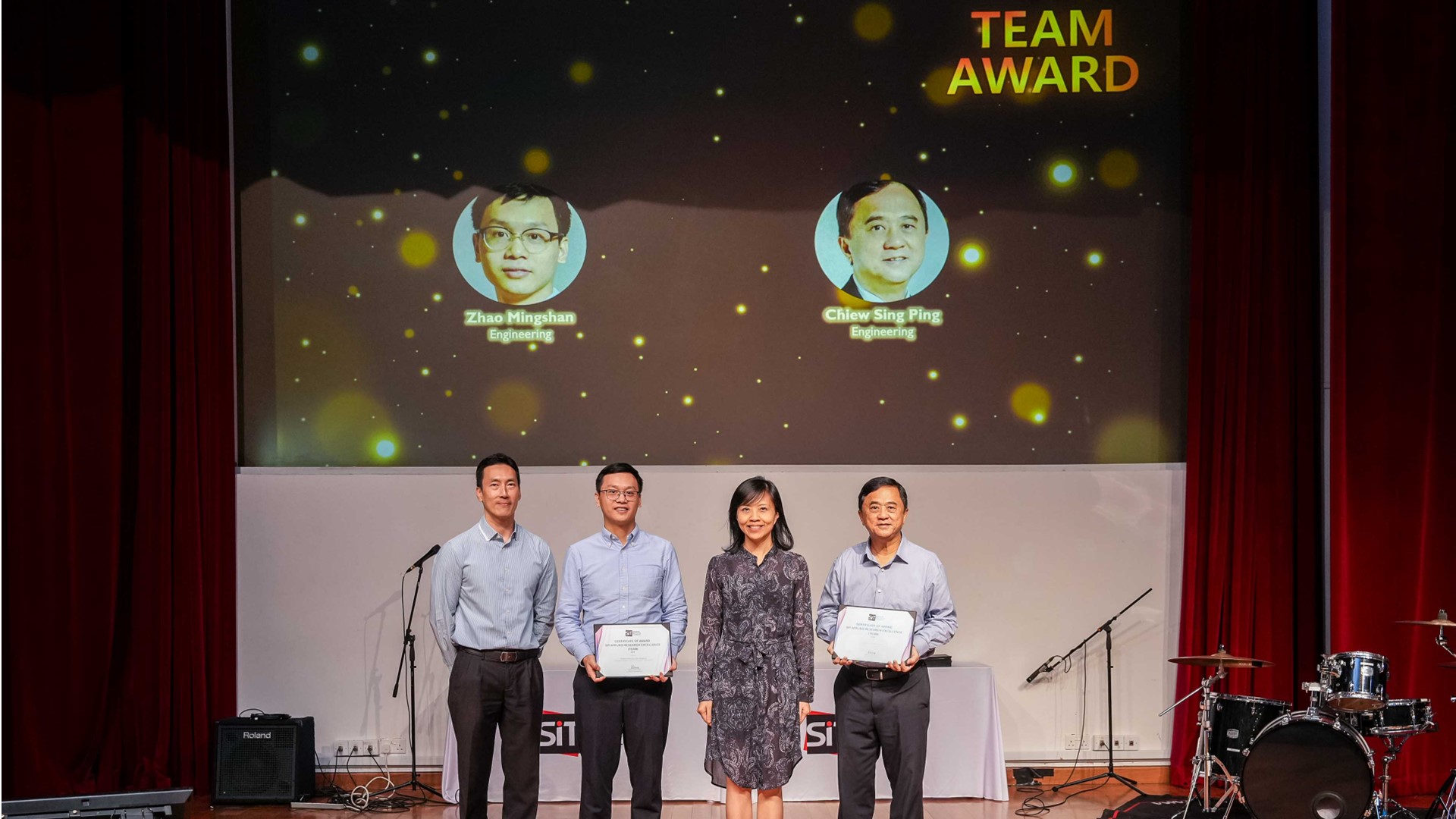
The team behind HISTEEL, comprising Professor Chiew Sing Ping (extreme right) and Assistant Professor Zhao Ming Shan (second from left), won the Applied Research Excellence Award at the SIT University Awards 2024. (Photo: Keng Photography for SIT)
A new skyscraper is being built in downtown Singapore. When the redeveloped Newport Plaza (once the Fuji Xerox Towers) opens, the 51-storey integrated development will house offices, residential and serviced apartments, and retail spaces. But to those in the construction industry, the most interesting feature of this building is hidden deep within.
At the core of the development lies an engineering breakthrough. The skyscraper’s kingposts, a building’s central supporting post, is made of S690 structural steel, a material never before used in construction in Singapore. That is, until now, thanks to two professors from the Construction Technology Innovation Laboratory (CTIL) at the Singapore Institute of Technology (SIT). This innovation has won the research team the Applied Research Excellence Award at the SIT University Awards 2024.
Stronger Building Blocks
While the average person may not pay much attention to the bones of our buildings, Professor Chiew Sing Ping, Head of CTIL, and Assistant Professor Zhao Ming Shan, Principal investigator at CTIL, consider them the core of their work.
The two have developed a welding protocol that makes it possible to use S690 steel in construction. S690 steel is almost twice as strong as the S355 steel commonly used today, having undergone quenching and tempering. This process involves rapidly heating and cooling the steel, refining its microstructure to enhance its strength properties. However, S690 steel only comes in long, flat steel plates, which are unusable in construction. The S355 comes in I- or H-shaped sections and is ready for use in construction. Furthermore, subsequent heat applied during welding creates weakened, compromised heat-affected zones in S690 steel, making it challenging to shape into usable structural shapes needed for construction. Prof Chiew and Asst Prof Zhao’s welding protocol has managed to overcome these limitations, while not adversely affecting its strength. The result is HISTEEL – high-strength steel sections made of S690 steel in ready-to-use shapes.
“This research demonstrates that high-strength steel plates can be welded and formed into HISTEEL sections without compromising their integrity. Although the welding process is not codified as a standard, it has gained significant traction. The Building and Construction Authority of Singapore (BCA) has approved numerous projects utilising HISTEEL sections, recognising their potential in modern construction,” Prof Chiew explained.
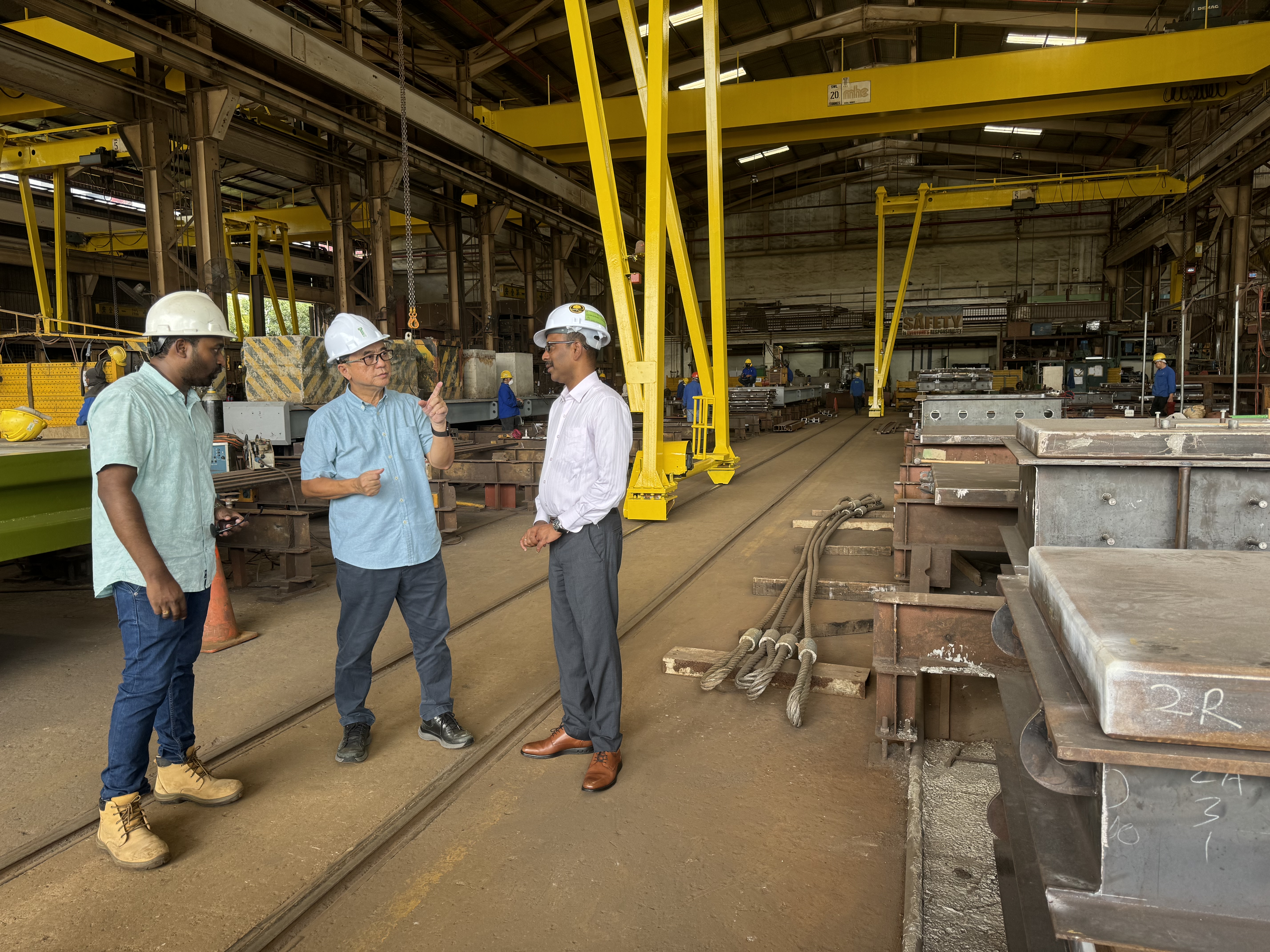
Prof Chiew (centre) and quality assurance and quality control managers from TTJ Design & Engineering discussed the fabrication process of the S690 king post steel sections at TTJ Design & Engineering's factory. (Photo: CTIL)
These steel sections require less material to build and are stronger yet lighter. Since they use up to 40 per cent less tonnage compared to conventional S355 steel, they are also a more sustainable option. HISTEEL also addresses the space issue that comes with urbanisation – because they are lighter, smaller cranes can be used to lift them, making them ideal for construction in crowded city areas.
“Weight is a critical factor in urban construction. Lifting lighter materials inherently improves both productivity and safety on the job site,” Prof Chiew said. The potential of S690 steel has been realised with this HISTEEL. Apart from the redeveloped Newport Plaza, kingposts made of S690 steel have since been used for the Marina View Residences as well.
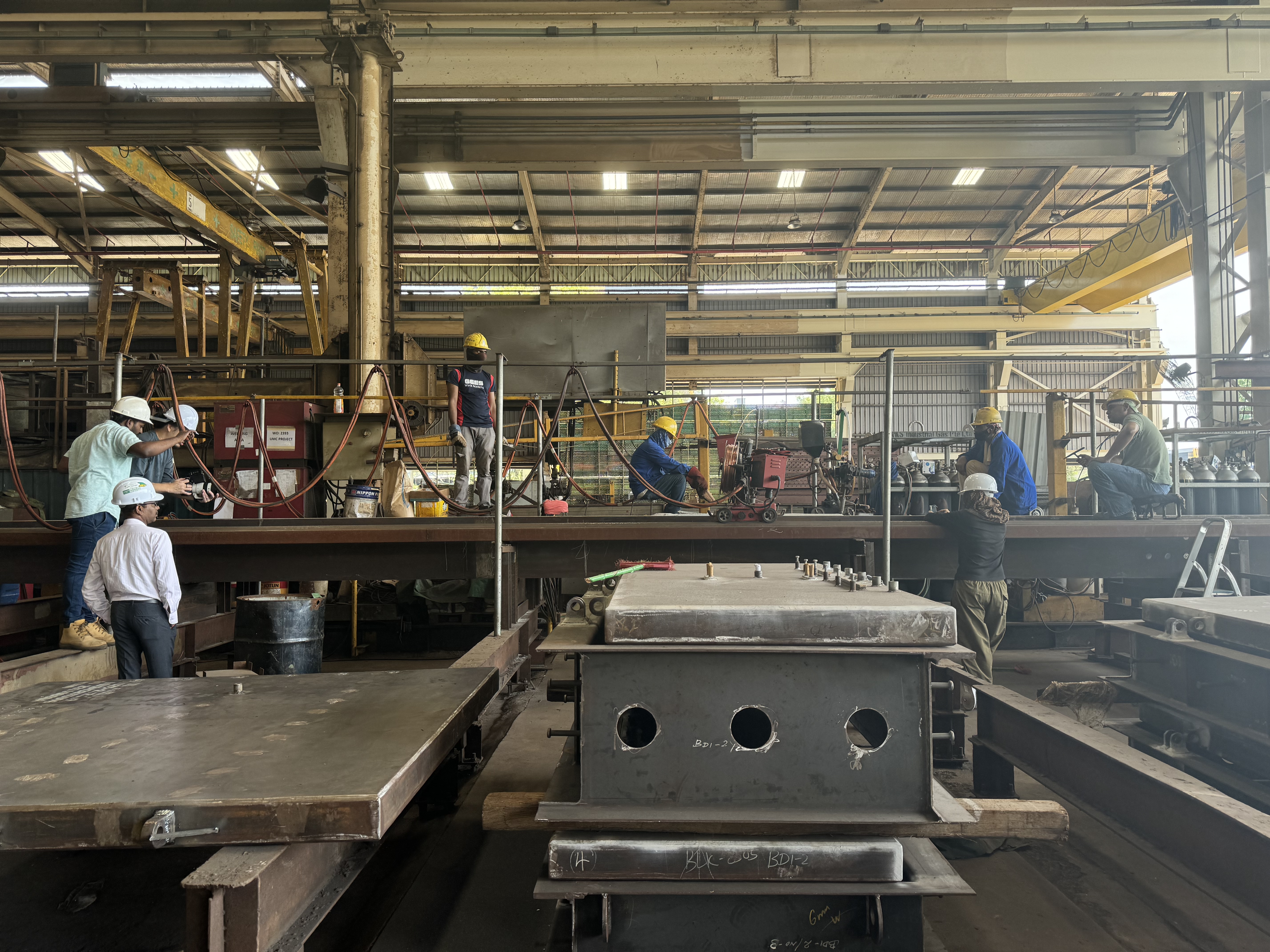
Fabrication of the S690 steel king post sections at TTJ Design & Engineering's factory. (Photo: CTIL)
Through a successful partnership between SIT, construction company Woh Hup and steel fabricator TTJ, who are using HISTEEL in both developments, an established welding process for S690 steel has been successfully developed and significant savings achieved. TTJ, as the fabricator of S690 steel sections, played a crucial role in producing the components, while Woh Hup deployed them in their construction sites.
Interest in the market extends beyond using S690 steel for kingposts, to sky bridges and other applications. By sharing their research outcome with industry, SIT has paved the way for wider adoption of this high-performance material in the construction industry.
Prof Chiew explains: “We work together with industry partners; we call this applied research. Collaborations with key partners like Woh Hup as our main contractor, TTJ Design & Engineering as the steel fabricator, and sometimes with developers have been instrumental. It’s important to have this kind of synergy in partnerships to drive industry transformation.”
The Strength of Tripartite Partnership
Prof Chiew and Asst Prof Zhao started researching S690 steel plates about 15 years ago. When they came to SIT, they were determined to bridge the gap between theoretical research and practical application for S690 structural steel. To do this, they would need more than a lab; they needed construction sites as their test-bed. But getting industry buy-in was not easy. The professors had to convince major players to try something new. In 2019, the professors went to major construction company Woh Hup with their research. They proved the effectiveness of their welding protocol, which preserved the steel's mechanical properties, even after being put through intensive heat from welding.
Woh Hup and the local authorities were convinced. They saw the value in using HISTEEL sections in their projects. Soon, all the moving parts of the developments were on board – the Qualified Person (QP), the design engineers and the developers.
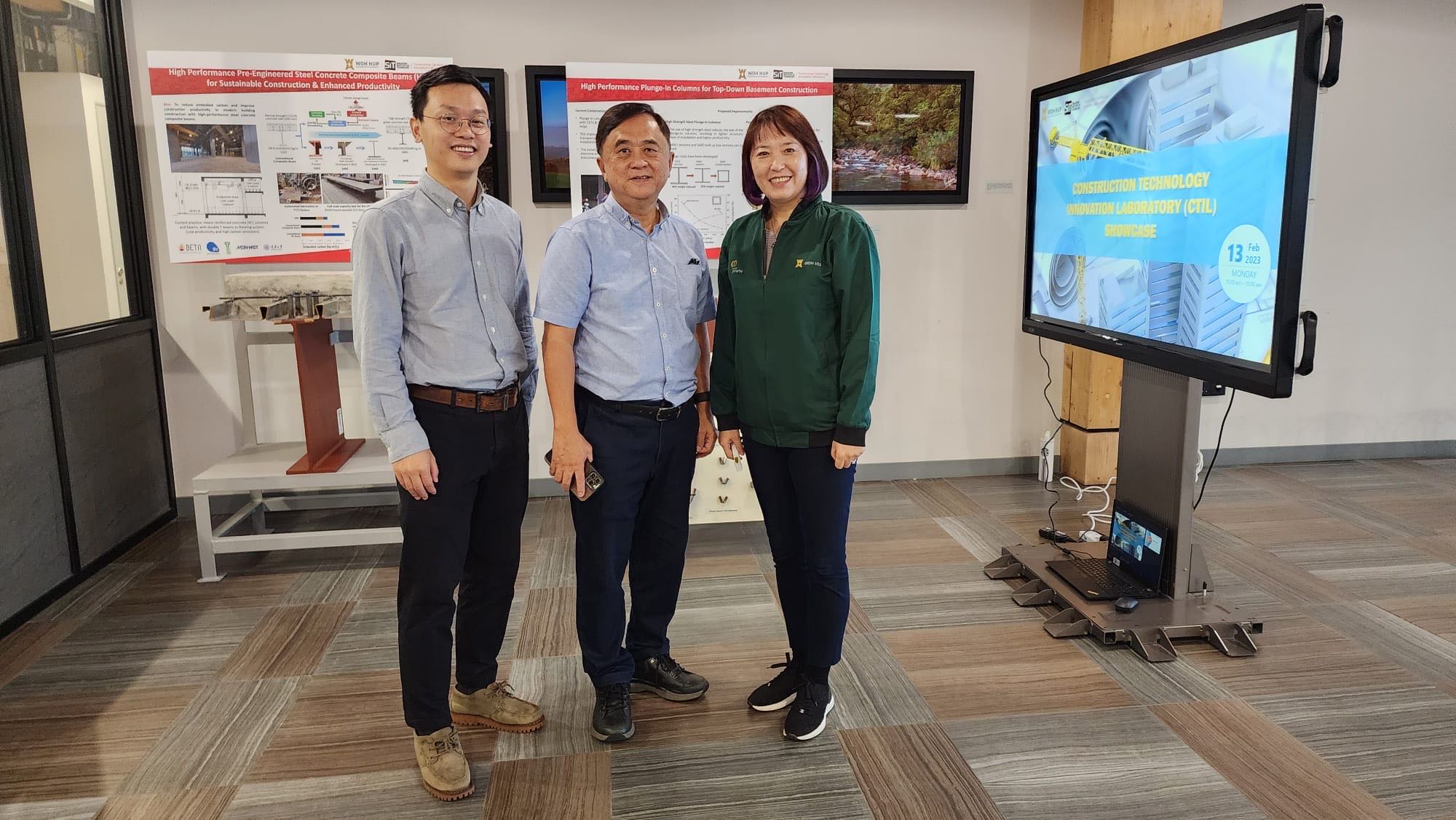
From left: Asst Prof Zhao Ming Shan and Prof Chiew Sing Ping from SIT’s Engineering Cluster; and Er Cong Zhengxia, Senior Director of Engineering (Building), Woh Hup at Woh Hup’s Tech Hub. (Photo: Woh Hup)
The construction industry is often seen as slow to evolve, with tight regulations and strict safety standards. However, the professors believe the tripartite partnership between the government, industry, and Institutes of Higher Learning provides the best chance for innovations to be implemented.
Asst Prof Zhao said, "The success of this project is a testament to the strength of collaboration between academia and industry. By working closely with our partners, we were able to translate our research into a real-world solution that is benefiting the construction sector,"
The installation of the kingpost, which was the culmination of all their research, was like any other day for the two SIT professors. Even with the deployment, they knew their work was not done, and both headed back to SIT’s CTIL to continue their research on using S690 steel for sky bridges.
“As Civil Engineers, we sometimes overlook the personal impact of our work. While our projects primarily benefit society as a whole, they can also translate into tangible solutions that bring improvements to people's daily lives. Seeing our research applied in real-world situations is very rewarding,” Prof Chiew said.
![[FA] SIT One SITizen Alumni Initiative_Web banner_1244px x 688px.jpg](/sites/default/files/2024-12/%5BFA%5D%20%20SIT%20One%20SITizen%20Alumni%20Initiative_Web%20banner_1244px%20x%20688px.jpg)
